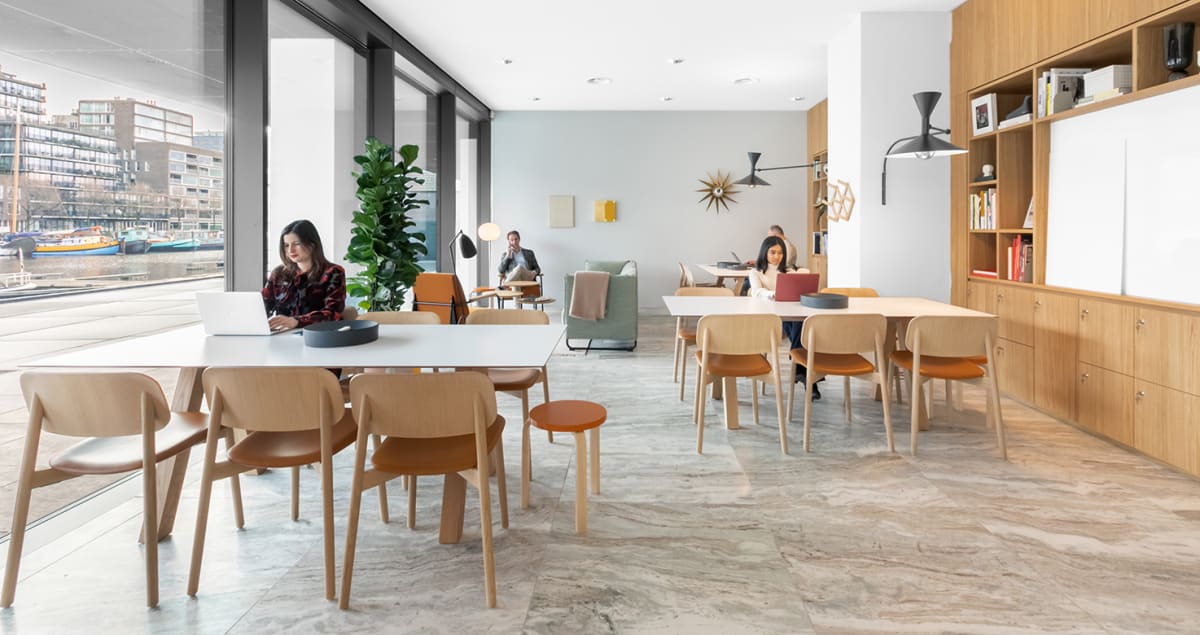As workers gear up for a hybrid return to the office, how can building owners prepare for this new way of working?
As vaccinations ease us on to a road out of the pandemic, there’s a growing impatience among workers to get back to the office – for some of the time, at least. A recent JLL survey showed that three in four workers want to return to the office - a quarter of them full time. It seems that workers overwhelmingly want a hybrid model in future – and building owners will have to redesign and engineer workspaces accordingly. What does that mean in practice?
Invest in quality
With fewer people in the office at any one time, companies may need fewer square metres, but the quality of that space will be at more of a premium. Since the office is no longer a mandate, it must become a magnet, says Elizabeth Lowrey, principal and director of interior architecture at Boston-based Elkus Manfredi Architects. No longer a sea of desks, she says, it should be “a genuinely welcoming place where employees want to be – a place of social connection and great tech, where they feel a sense of belonging and can do their best work.”
Elasticity is key
Workspace will have to work harder. Yes, quieter areas and more sociable spaces will be needed, but there should also be less emphasis on rigid designation and segregation. Multi-functional areas will be the order of the day – for example, an area of individual workstations may be expected to morph into a meeting space when required. Nothing should be fixed, says Lowrey: “Designers must create spaces with flexibility to pivot and adapt to new ways of working – so that when the next crisis happens, it doesn’t feel like a catastrophe, but more like a speed bump.”
Start with user experience
Working from home, people will be more conscious of their own optimum work patterns than ever before. This means a unique opportunity to redesign operations around your workforce’s actual needs. After Standard Chartered bank signed its landmark deal enabling employees to use IWG’s global workspaces, the company’s Head of Talent, Tanuj Kapilashrami explained this employee-inspired approach. “It’s this idea of co-creating the future of work with our colleagues. Currently, 70-80% of our workspaces are not designed around collaborative, task-based work - going forward, colleagues want the majority of workspaces to be designed around this.” Companies will have to ask their people what they need to do their job effectively – from hours to meeting styles to IT support – as well as any roadblocks they’ve encountered while working from home, in order to develop an environment and a process that works best for everyone.
Embrace video technology
During the pandemic, video has finally become established as a mode of everyday interaction – and that will continue under hybrid working patterns. In future, its chief use is likely to be seamlessly integrating colleagues at in-person meetings with those joining remotely. One solution will be to supply workers with ‘Zoom rooms’ – with integrated screens, high-quality sound installations and voice-tracking technology that can follow who is speaking. Pods that maintain separation and insulate the sound from those around you are another option, adds Elizabeth Lowrey.
Prioritise wellbeing
Emerging from the pandemic, employees will have unprecedented expectations about wellbeing, health and safety. Factors such as air quality, mental and emotional wellbeing will now be on the average worker’s radar, says architecture, design and planning firm Gensler. Workers will be highly conscious of hygiene and social distancing, so one response will be to enable ‘touch-free’ journeys, in which employees can use their own smartphone to navigate the building. Another might be using gesture, voice or facial-recognition technology to open doors and gain access. According to research firm Forrester, these are only a few of a raft of new measures that will have to be considered by building owners: including contact tracing, temperature measurements, safe zones in lifts, using UV lights to disinfect space, and even Plexiglas barriers between workstations.
Flexible workspace is the fastest-growing sector of the global workplace market. Find out how IWG can help transform your property into a hybrid workspace.






